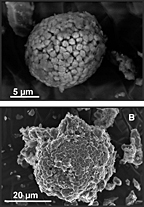- Number 303 |
- January 18, 2010
Fool’s gold proves valuable to scientists studying uranium

By integrating resources,
the
team obtained
extremely detailed
views of the framboidal
(French
for raspberry)
pyrites found in
the
sediment of interest.
The top
image is of a
sphere-like structure
and the bottom image
is an irregular
framboidal
structure.
Under some contaminated sites, microbes and the mineral pyrite or fool’s gold can seriously alter uranium’s travel plans, according to a new study by DOE’s Pacific Northwest National Laboratory and Argonne National Laboratory. This study, which used resources at DOE’s EMSL and the Integrated Field Challenge Site in Colorado, provided the first-ever evidence that pyrite and uranium interact in alluvial sediments with active microbial communities. The uranium-containing framboidal pyrite may slowly release the adsorbed uranium upon the return of oxygenated conditions. Understanding how and when uranium migrates may aid in creating remediation approaches to extract or halt the radionuclide’s movement.
[Kristin Manke, 509.372.6011,
kristin.manke@pnl.gov]
